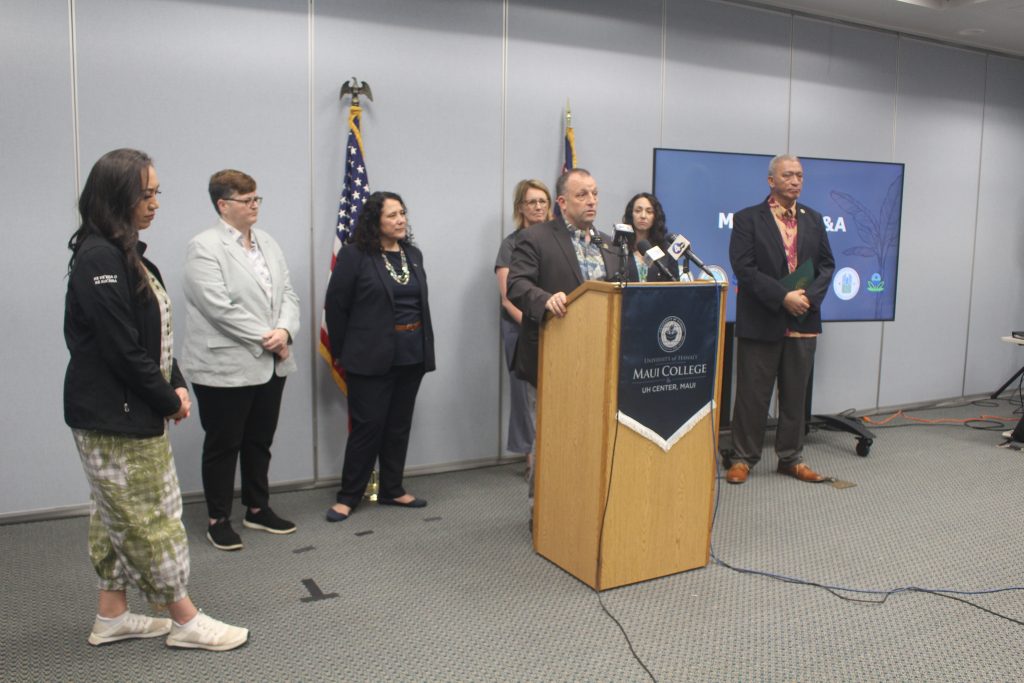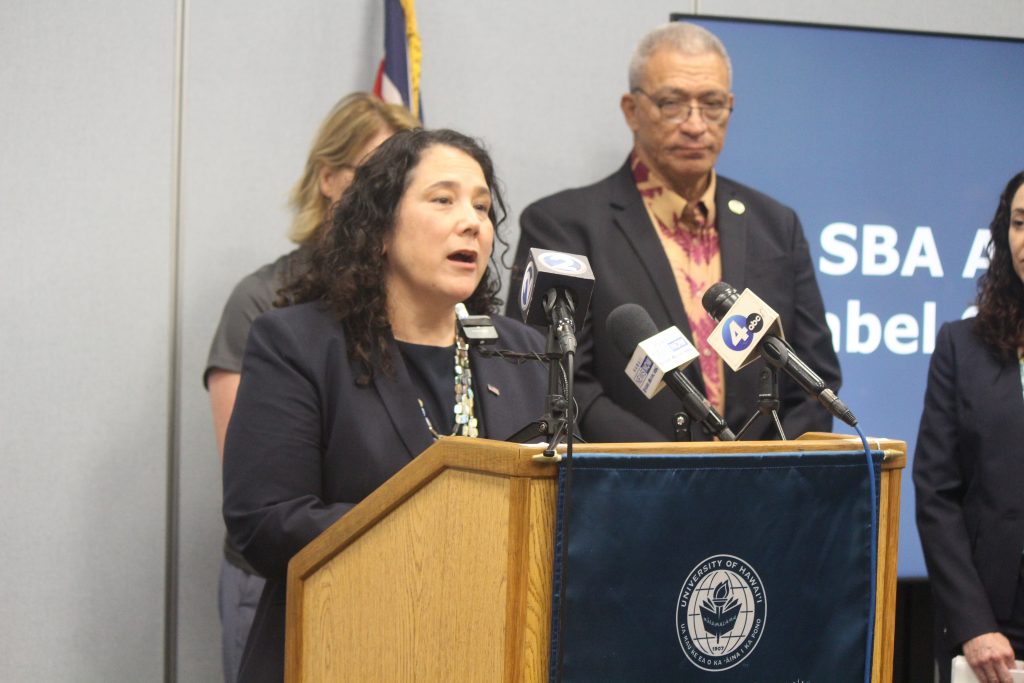6 month Maui wildfire update: Gov. Green says moratorium ‘not likely’ needed, sets sights on long-term housing policy
Today, Gov. Josh Green, M.D. expressed confidence that positive progress is being made in the transition of wildfire survivors from hotels to long-term housing, making a moratorium on short-term rentals “not likely.”
He floated the moratorium idea during a December press event saying he hoped 3,000 short-term rental owners would convert to long-term housing for fire survivors. The idea was to gain compliance or implement a ban on short-term rentals. A month later, he joined other government leaders and nonprofit organizations in unveiling a $500M Maui Interim Housing Plan.
“Because of the incredible success of the mayorʻs program, and the effort that FEMA and DHS have [made], it’s not likely we’ll need the moratorium and we will meet our needs by March 1. The number of housing units will meet the need[s] that the families have at this pace,” said Gov. Green during a joint press conference held this morning at the University of Hawai’i Maui College in Kahului.
The comments come six months to the day since the August 2023 wildfires and the devastating impacts on Lahaina and the Maui community.
“Going forward, weʻre going to continue to review the landscape of long-term rentals and short-term rentals in our state. Itʻs now become clear that this is a statewide issue, highlighted by the crisis on Maui. We’ve asked the legislature, which is in session right now, to do all that it can to both provide incentives and allow me to bring significant enforcement to bear to get people to move from short-term rentals to long-term rentals.”
According to the governor, there are 90,000 short-term rentals in our state—75,000 of those are illegal, he said. On Maui alone, there are 31,000 short-term rentals.
“Though it would appear we have enough to take care of those families who were displaced, we still have a housing crisis. So expect this to be a long-term policy question for us to move tens-of-thousands of short-term rentals into local families’ possession,” said Gov. Green.
Lahaina Strong organizer Jordan Ruidas responded to the update saying, “In this horrible moment of disaster, an option has been on the table to do the right thing for local people — a moratorium on West Maui vacation rentals to house our people — and the Governor previously expressed willingness to do it gave our people much needed hope that something good might come out of this crisis…”
She said local people continue to suffer and asked government leaders, “to choose local need over off-island greed.”
The Lahaina Strong Hui’s “Fishing for Housing” occupation on Kāʻanapali Beach is now in itʻs 90th day of demanding urgent action on dignified housing solutions for displaced fire residents.
Gov. Green was joined by Maui County Mayor Richard Bissen join SBA Administrator Isabel Casillas Guzman, FEMA Administrator Deanne Criswell, and other government agencies. The leaders highlighted progress made over the past six months, current efforts, and the path forward for Maui’s recovery.
Six months after wildfires tore through historic Lahaina Town, cranes, excavators and bulldozers are clearing the lots of debris.
“One by one, they’re removing what’s left of houses that burned and the melted husks of cars and pickup trucks left abandoned. Environmental crews are keeping tabs on air, water, and soil samples. FEMA continues to work closely with the state of Hawai‘i, including state Coordinating Officer James Barros, as well as Maui County, and federal and nonprofit partners, to put Lahaina on a path to recovery,” according to a news release update.
Gov. Green provided a recap on mid- to long-term housing and the various programs the state, county and partners are offering.
“That includes those who were homeless before the fires, to our workforce members who rent, including first responders who lost their homes even as they evacuated and rescued their neighbors, to the longtime homeowners who lost everything, and all who lost loved ones. Our efforts now, every day, are to transition survivors’ households into long-term housing, to give them stability and a sense of normalcy,” said Gov. Green in a news release. “Our Maui Recovery Fund, part of our One ‘Ohana Initiative,” will go even further to help our neighbors on a path to recovery,” he said.

An estimated 9,806 people have been displaced because of the wildfires, 3,971 properties were destroyed, and 100 lives were lost in the fires, marking the nation’s deadliest fire in over a century.
“Thanks to our partners we were able to successfully house 7,796 individuals in the NCS program. Currently there are still 4,961 people or 2089 households, in 17 hotels, in need of housing. Our goal is to swiftly move individuals into long-term housing,” said Gov. Green.
According to the governor long-term rentals have been secured 2,367 wildfire survivors. There is still a need for an additional 500 units to fully house survivors of the wildfires, but Gov. Green said the state is “well on track” to secure housing.

“On Aug. 8, our island and community were forever changed by the devastation of the Maui wildfires,” said Maui Mayor Richard Bissen.

“As I reflect back over the last six months, I am incredibly appreciative of the continuous outpouring of aloha that we have received from across our pae ʻāina and from around the world. From day one, Maui has truly felt the embrace of so many. The care and resilience of our community, paired with the support of our federal, state, and local partners through this disaster have been unwavering. As we look forward, we remain acutely focused on prioritizing the mental health and well-being of our survivors, and our shared commitment to provide a place for them to call home.”
As of this morning, Mayor Bissen said 60 residential properties have been cleared of debris and another 71 are in progress. According to Mayor Bissen, the County of Maui has committed to building approximately 500 interim units—200 of them in West Maui, and another 250-350 accessory dwelling units have been identified throughout the county.
Crews from USACE are cleaning residential properties in Lahaina and plan to expand to commercial and public properties by mid-March, according to the state update. The debris is currently being transported to the eight-acre temporary debris storage site four miles away in Olowalu.
USACE is also working toward completion of work on a new $53.7 million school project to serve as the temporary replacement for the King Kamehameha III Elementary School, which was destroyed in the fire. The temporary site, near the Kapalua Airport, will be handed over to educators in late February. Classes for 600 students are expected to start April 1.

SBA Administrator Isabel Casillas Guzman said the SBA has directed more than $290 million in loans to small business owners, nonprofits, homeowners, and renters seeking to rebuild their lives. “We know there is still a long road ahead to economic recovery, and the SBA stands ready to work alongside federal, state, local, and private partners to ensure all of the communities impacted can reimagine and rebuild leveraging the full resources of the SBA,” she said in a news release recap.
Congressman Ed Case is among the legislators who introduced bills to address the impacts of Maui’s wildfire disaster. HR761 seeks to provide loans and other financial assistance to small businesses affected by the wildfires on Maui.
At the state level, bills and resolutions aligning with recommendations outlined in the Final Report of the House of Representatives Lahaina Wildfire Interim Working Groups were also introduced.
FEMA Administrator Deanne Criswell said the people of Maui have been through one of the worst disasters in the nation’s history. “Their resilience, resolve, and perseverance have been remarkable, and their careful consideration of community throughout the recovery process should act as a model for future operations,” she said.

She vowed commitment from FEMA, and the Biden-Harris Administration, to continue to work with the state and local officials of Hawai‘i “for as long as it takes” to ensure the recovery of Lahaina.
Administrators Criswell and Guzman visited the Lahaina Disaster Recovery Center and met with nonprofit organizations as part of their update. This is Criswell’s second visit to the recovery center. In August, she attended a town meeting with President Biden when he visited the island with the first lady.
Chief Federal Response Coordinator and FEMA Region IX Administrator Bob Fenton said his goal is to move 1,500 wildfire survivors out of Maui hotels and into more suitable temporary housing. “To date, FEMA has secured nearly 1,500 leased properties for survivors, and more than 160 households have moved into temporary housing through FEMA’s Direct Lease program,” according to the update.
“In the long days, weeks, and months that follow a disaster, housing is one of the most pressing needs,” said HUD Principal Secretary for Community Planning and Development Marion McFadden. “Whether it’s helping HUD-assisted households, ensuring homeowners have the flexibility they need to rebuild, or providing emergency shelter for those experiencing homelessness through our RUSH grant funding, HUD is committed to working alongside our federal and local partners to support Maui’s recovery.”
EPA Region 9 Deputy Administrator Cheree Peterson said 200 tons of hazardous material has been removed from the burn area today. “We will ensure our work is done with the utmost respect and reverence for your home, history, and culture,” she said.

The EPA removed damaged household appliances, 30 tons of lithium batteries, and other hazardous materials from the 5-square-mile area of the Lahaina burn zone. The US Coast Guard raised 96 boats from the harbor, including a commercial submarine.
Peterson said the EPA is now focused on drinking water and wastewater, and restoring service so residents can move back to their properties.
“Our first mission is to inspect and clear over 95,000 linear feet of sewer line utilities,” said Peterson. After four days, the EPA has completed 20% of that mission. According to Peterson, the process involves the clearing of sewage pipes and inspection.
The second focus is on drinking water. “The wildfire caused widespread heat-induced damage to pipes as well as loss of pressure, which could have caused volatile compounds to be introduced to the pipes,” said Peterson, noting that more than 2,000 pipes will be sampled to ensure that if contaminants are present, they will be isolated.

*This is a developing story and was updated with additional information including links to legislation and comment from the Lahaina Strong organization. Supporting details courtesy Office of Gov. Josh Green.


















